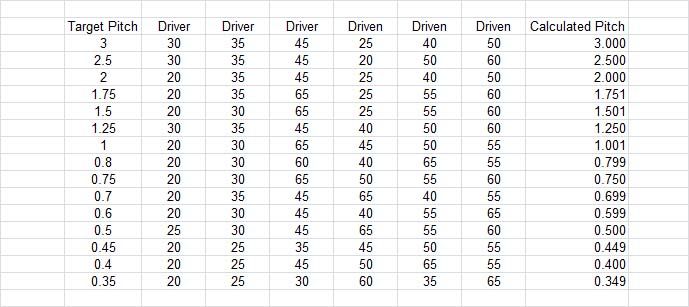Just in case anyone thinks 63 is a 'good enough' approximation to 127/2=63.5, it is probably OK for a rough and ready fixing with 4 or 5 threads engaged, but see the extract below from an article I wrote back in the mists of time…
What if we want to cut metric threads on an imperial machine, or vice versa? One can change over the leadscrew, but this takes time, as the apron must be removed and the clasp nuts replaced and adjusted as well. Is there an easier way?
One inch equals precisely 25.4 millimetres (though at various times in the past it has not!) If we had a 254 tooth changewheel in our set-up, we could convert precisely between the two systems. There is a problem though, a 1-module 254-tooth gear is 256mm in diameter! A 127 tooth gear could be used, as it is exactly half of 254, but it would still be about 5” across. You could accommodate such a gear by making a new mounting banjo, but you would also need to add further idler gears. The whole set-up would be rather clumsy.
The answer is a 63-tooth gear. It may seem that 63 is ‘close enough’ to half of 127 to do the job, but it isn’t – it would produce errors of around 2%, acceptable for some purposes, but not for many others. The 63 tooth gear arises from another, fortuitous bit of maths.
1mm pitch is 25.4 threads per inch. To cut 25.4 tpi on a 16 tpi leadscrew we need a ratio of 16:25.4, this works out at 0.62992:1, or almost exactly 63:100. If we introduce the ratio 63:100 into our gear train then a 16 tpi leadscrew will cut a 1mm pitch thread well within the tolerance of any other aspect of the process. To translate this into standard change wheels we can use:
63/100 = 63/50 *1/2=63/50 x 30/60
Conversely, a ratio of 100:63 will allow a 1mm metric leadscrew to cut a 16tpi thread with the same accuracy. In fact, the standard metric leadscrew for mini lathes has a pitch of 1.5mm, which would therefore cut 16 x 1.5 = 24 tpi, but this is dealt with by putting the ratios 2/3 and 100:63 in series.
(typo 127/2=63.5)
Edited By Neil Wyatt on 12/01/2020 18:57:32
 Neil Wyatt.
Neil Wyatt.





